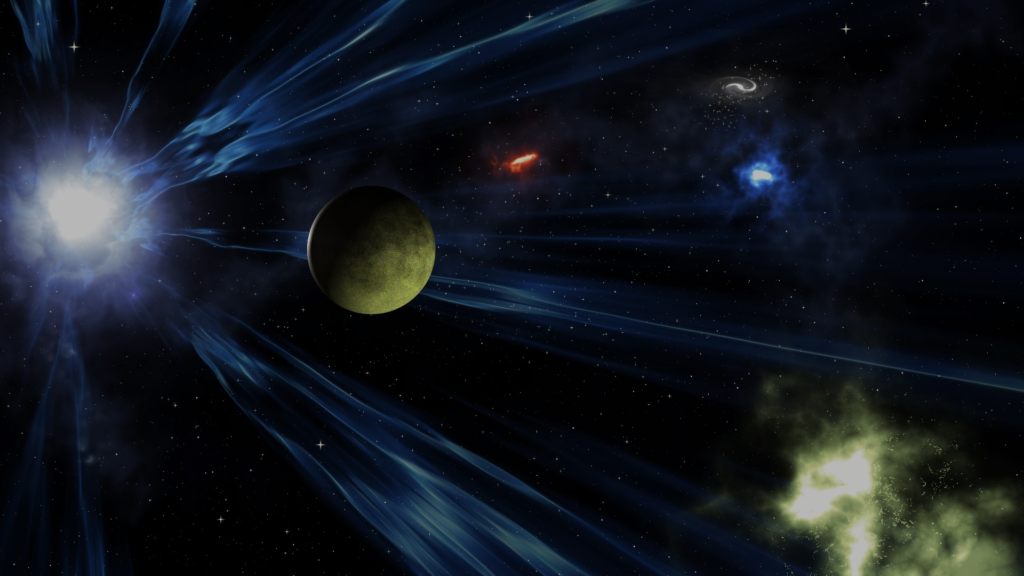## Unveiling the Mysteries of Black Holes: Cosmic Vacuum Cleaners
Have you ever imagined a place where gravity is so strong that not even light can escape? That’s the mind-bending reality of a black hole, one of the most fascinating and mysterious objects in the universe. These cosmic titans aren’t just science fiction; they are real, powerful entities that play a crucial role in shaping the galaxies we see. Let’s dive into the swirling abyss and unravel some of their deepest secrets!
### 1. From Stars to Stellar Remnants: The Birth of a Black Hole
Black holes aren’t born in a vacuum; they’re the dramatic endpoints of a star’s life cycle. Imagine a star many times more massive than our Sun. These behemoths burn through their fuel at an incredible rate, undergoing nuclear fusion that creates heavier elements. When the fuel runs out, gravity takes over with a vengeance. The star’s core collapses in on itself, creating an incredibly dense object. If the remaining core is massive enough (typically more than three times the mass of our Sun), the gravitational pull becomes so immense that it crushes all matter into a singularity – a point of infinite density. This singularity is the heart of a black hole, surrounded by an event horizon: the point of no return, beyond which nothing, not even light, can escape.
Think of it like a drain in a bathtub. The water swirling down the drain is similar to matter being pulled towards the singularity. Once the water (or matter) crosses the point of no return (the event horizon), it’s gone forever.
### 2. The Event Horizon: A Point of No Return
The event horizon is a crucial feature defining a black hole. Its radius depends on the black hole’s mass; more massive black holes have larger event horizons. This isn’t a physical surface, but rather a boundary beyond which the gravitational pull is insurmountable. Anything that crosses the event horizon is inexorably drawn towards the singularity, its fate sealed.
While we can’t directly see the singularity, we can observe the effects of a black hole’s gravity on its surroundings. For example, the intense gravity warps spacetime, bending the path of light passing nearby. This creates a phenomenon called gravitational lensing, where light from distant objects is magnified and distorted.
### 3. Supermassive Black Holes: Giants at the Galactic Center
While stellar-mass black holes (formed from the collapse of individual stars) are fascinating, the truly mind-boggling ones are supermassive black holes. These behemoths, millions or even billions of times the mass of our Sun, reside at the centers of most galaxies, including our own Milky Way. How they form is still a topic of active research, but one theory suggests they grow by accreting matter and merging with other black holes over billions of years.
These galactic giants influence the entire galaxy’s structure and evolution. Their gravity shapes the orbits of stars and gas clouds, influencing the galaxy’s spiral arms and overall dynamics.
### 4. Detecting the Invisible: Observing Black Holes
Since black holes don’t emit light, detecting them requires indirect methods. Scientists rely on observing the effects of their gravity on surrounding matter. This includes:
* **Accretion disks:** Matter spiraling into a black hole forms a superheated disk that emits intense radiation across the electromagnetic spectrum, from X-rays to radio waves. This radiation can be detected by telescopes.
* **Gravitational waves:** The merger of two black holes creates ripples in spacetime, called gravitational waves, which can be detected by highly sensitive instruments like LIGO and Virgo.
### 5. Unanswered Questions and Future Research
Despite our growing understanding, many questions remain about black holes. What happens to information that falls into a black hole? How do supermassive black holes form? What role do they play in the evolution of the universe? These are just some of the exciting questions driving ongoing research.
**In conclusion,** black holes are extraordinary celestial objects that defy our everyday understanding of physics. From their dramatic birth to their powerful influence on galaxies, these cosmic vacuum cleaners offer a window into the most extreme environments in the universe. We encourage you to explore further, delve into the wealth of resources available online, and share your thoughts in the comments below. What mysteries of the universe intrigue you most?


